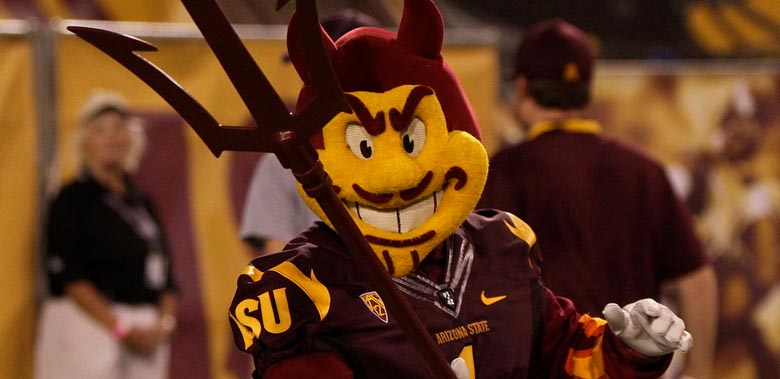From a Liability Standpoint, It’s Time to Get Rid of Mascots

Photo credit: https://www.flickr.com/photos/neontommy/
By Joshua D. Winneker, J.D. & David Gargone, Ed.D.*
It seems unbelievable, but another fan was seriously injured recently by a team mascot.[1] These in-the-name-of-fun actions should not be treated trivially as the shenanigans of the characters – whether they represent an NCAA institution of higher education or a professional sports franchise – expose their employers to potentially expensive litigation.
The most recent example occurred to Tempe City, Arizona, Councilman David Schapira at an Arizona State University (ASU) home football game.[2] Schapira was on the sidelines for the game when Sparky, ASU’s mascot, attempted to photobomb him and jumped on his back.[3] Unbeknownst to Sparky, Schapira was recovering from back surgery.[4] His impromptu, uninvited piggy-back ride caused Schapira to experience a muscle tear that is going to set back his recovery by six weeks and force him to miss work.[5] Sparky immediately apologized, and the university followed shortly thereafter. The university also offered to pay Schapira’s medical expenses.[6]
Luckily for ASU, Schapira is an ASU fan and does not appear to be seeking legal compensation, but this incident certainly begs the question of why do university athletic departments and professional sports franchises continue to employ mascots when they are a walking liability? This is certainly not the first time a fan has been injured by a mascot and it will not be the last either until mascot antics are either completely toned down or done away with all together.
Sluggerrr of the Kansas City Royals is the poster child for mascot liability following last year’s Missouri Supreme Court decision that ruled in favor of an injured fan and against the Major League Baseball team.[7] This prior opinion certainly does not bode well for Sparky and other mascots whose antics are imputing potential liability to their respective schools and teams.
In Sluggerrr’s situation, the mascot did not jump on anyone’s back and cause injury; rather Sluggerrr threw a wrapped hot dog – as part of a ritual frankfurter toss at Royals’ home games – and hit a fan in the eye, causing serious eye damage and numerous surgeries.[8] The fan’s lawsuit against Sluggerrr’s employer, the Royals, focused on whether or not the Royals’ fan actually assumed the risk of the hot-dog-related injury when he entered the ballpark for the game.[9] Teams typically can defend against spectator liability lawsuits by claiming fans knew of the inherent risks of the sport prior to attending the game.[10] For the injured Royals fan, he believed, and so did the Missouri Supreme Court, that getting hit with a wrapped hot dog – instead of a batted ball – by a team mascot is not an inherent risk in a baseball game.[11]
For mascots like Sparky, if Schapira did decide to sue because he was seriously injured, he has some persuasive precedent to point to from Missouri. Additionally, an appellate court in California previously ruled similarly, and in favor of an injured spectator, because the mascot’s antics were not considered an essential or integral part of playing a baseball game.[12] The same would likely be true for Sparky’s antics at the ASU football game.
The mascot experience for fans used to just be a harmless moment or two during the game to help enhance the entertainment atmosphere. Now, the unpredictable nature of mascots’ actions has caused injury to spectators and potentially successful lawsuits against teams and schools. Indeed, the Denver Nuggets’ mascot Rocky recently engaged in a completely over-the-top tackle of a youth football player, which also could have resulted in serious injury – but to a child instead.[13]
It may be comical for some to think that teams and schools could be sued because of their mascots. The Royals’ fan who was injured by Sluggerrr certainly isn’t laughing. And Schapira, while he has seemingly shaken off his Sparky-related injury because of his support for ASU, might have felt differently had this same injury been caused by a rival university’s mascot.
* Joshua D. Winneker, J.D. & David Gargone, Ed.D., Assistant Professors, Misericordia University.
[1] See Nick Bromberg, Arizona State Mascot Sends Tempe Councilman Back to Hospital, Yahoo Sports (Sept. 24, 2015), http://sports.yahoo.com/blogs/ncaaf-dr-saturday/arizona-state-mascot-sends-tempe-councilman-back-to-hospital-192052502.html.
[7] Joshua Winneker & David Gargone, At Sporting Events, Beware the T-shirts Cannon, Pennlive.com (June 27, 2014), http://www.pennlive.com/opinion/2014/06/at_sporting_events_beware_the.html; see Coomer v. Kansas City Royals Baseball Corp., 437 S.W.3d 184 (Mo. 2014) (en banc).
[8] See generally Joshua D. Winneker et al., Who Let the Dogs Out: Should a Stadium Owner be Held Liable For Injuries Sustained From a Mascot’s Errant Hot Dog Toss?, 21 Moorad Sports L.J. 369 (2014).
[11] See Winneker & Gargone, supra note 7.
[12] See Lowe v. Cal. League of Prof’l. Baseball, 65 Cal. Rptr. 2d 105, 111 (Cal. Ct. App. 1997).
[13] See Will Brinson, Nuggets Mascot Rocky Obliterates a Kid at Halftime of Broncos game, CBS Sports (Sept. 3, 2015), http://www.cbssports.com/nfl/eye-on-football/25289830/nuggets-mascot-rocky-obliterated-a-kid-at-halftime-of-broncos-game.

